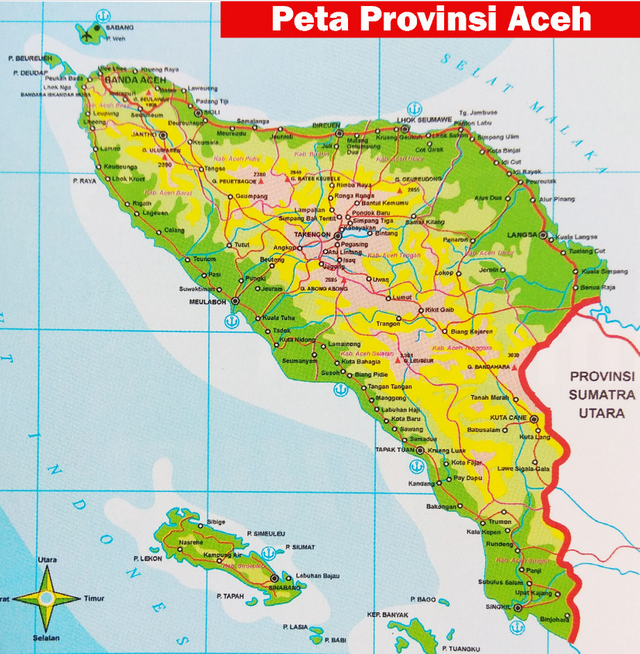History of Aceh Parth 1
Aceh is located in the northernmost part of the island of Sumatra and the westernmost part of the Nusantara archipelago. Accompanied by dozens of large and small islands, the region is now a special autonomous province of the Republic of Indonesia.
It is noted from maps, such as those depicted by scholar Van Heekeren in his book, which also take into account the past occurrence of droughts and straits separating Sumatra, Java, and Kalimantan from the mainland of Asia during the Ice Age in ancient times, that Aceh at that time was a cape accompanied by a wide bay extending to the estuary of the Irriwadhy River, Burma. In another part, further east of Aceh, there is an area that allows for land migration by ancient creatures who have not yet achieved the ability to navigate the sea.
Thus far, only in Java have fossils of ape-men or apes as bipedal humans (pithecanthropus erectus) been found, estimated to have lived between 300,000 and 500,000 years ago, similar to the ape-men found in Peking or ancient creatures like those in Europe. Thus, migration from or to there is not impossible.
The last phase of the Ice Age took place 40,000 years before Christ. After Sumatra, Java, and Kalimantan separated from the mainland of Asia, around 10,000 years before Christ, the perfect early human species (Homo-Sapiens) appeared in Indonesia. Their remains are in the form of skulls (fossils) found in Wajak, near the southern coast of Central Java.
Observing the development of the abilities of these early humans, who gradually progressed from primitiveness to various simple capabilities in their times, it can be inferred that the division of eras experienced by ancient humans includes three Stone Ages: namely the Old Stone Age (Paleolithic), the Middle Stone Age (Mesolithic), and the New Stone Age (Neolithic). It is beyond the author's ability to elaborate on the cultural developments of these centuries. Here, the intention is merely to provide a brief overview of Aceh's initial involvement since the Stone Age, based on the materials found.
As far as can be ascertained, the involvement of this region from prehistoric times can only be traced back to the Middle Stone Age (Mesolithic). Dr. H. Kupper noted the discovery of whetstones at four excavation sites in Aceh: three in North Aceh, namely in Krueng Geukueh in Bukit Pangoi not far from the railway, and in Kandang; the other is located in East Aceh, between Kuta Binjei and Alue Merah.
Initially, these whetstones were named Sumatra-Lith (Sumatran axes), but in reality, such tools are not specific to Sumatra but are known in various other regions, especially in mainland Asia. From this recognition, it actually makes it easier for people to research the origins of the inhabitants of a particular region or area.
The discovery of artifacts (tools) in Indochina, including in Bacson (north of Tonkin) and in Hoa Binh (southeast of Hanoi), leads people to consider that these areas were the origin of the Middle Stone Age culture (Mesolithic) that migrated southward (Muang Thai, the Malay Peninsula, and various places in the Indonesian archipelago, including Aceh). Also, with the discovery of shell mounds (food remains) and some tool fragments buried deep along the coast from Medan to East Aceh, this strengthens that calculation. And based on the tools found in Bacson and Hoa Binh above, the inhabitants of that era are classified as supporters of the Bacsono-Hoabinhian culture, taking the name of the place where the clues were found.
They are characterized by black skin, slightly curly hair, a flat nose, and a slightly short body. The inhabitants who later moved away from the forest, as known in Sri Lanka, known as the Vedda people with those characteristics, are descendants of the people who supported the Bacsono-Hoabinhian culture. Supporters of the same culture are known in Malaysia as the Senoi and Yakun people; in Indonesia as the Sakai, Kubu, Mentawai, Enggano, and Toala people in Sulawesi.
Near Melbourne, Australia, a skull was found named the Keilor skull, after the location of the discovery. From expert investigations, it turns out to be the ancestor of the original Australian inhabitants who are now marginalized. This is also classified as a supporter of the culture mentioned above, as is the case with the Melanesian people who live in seclusion in various islands of the Pacific Ocean. It is very likely that the Mesolithic (Middle Stone Age) or even the Early Stone Age (Paleolithic) people in Central Java, known as the Wajak people, migrated to Australia in these Pacific islands, both before and after the arrival of new migrants.
